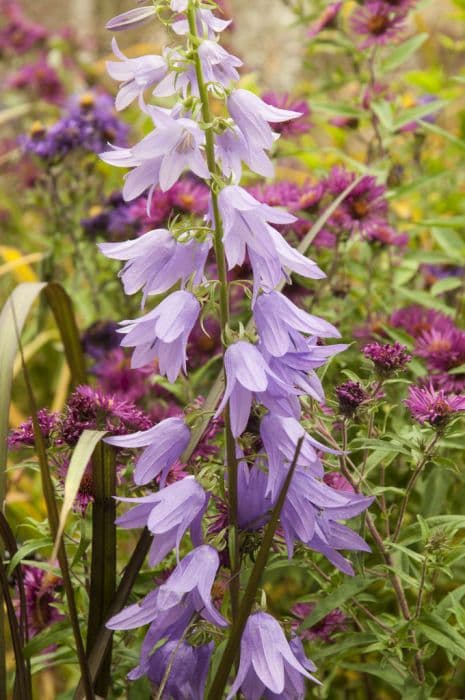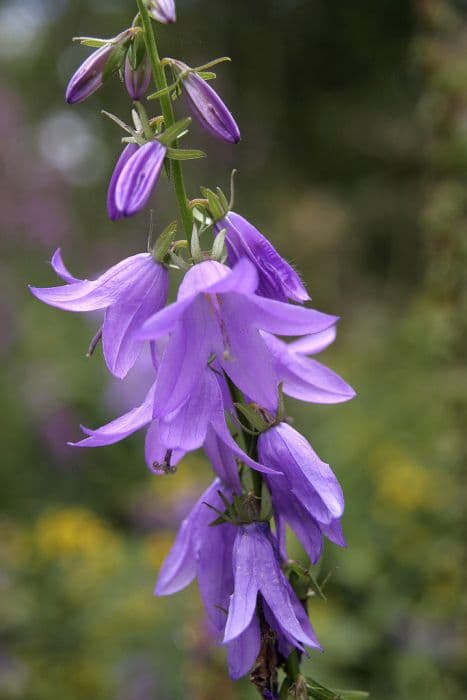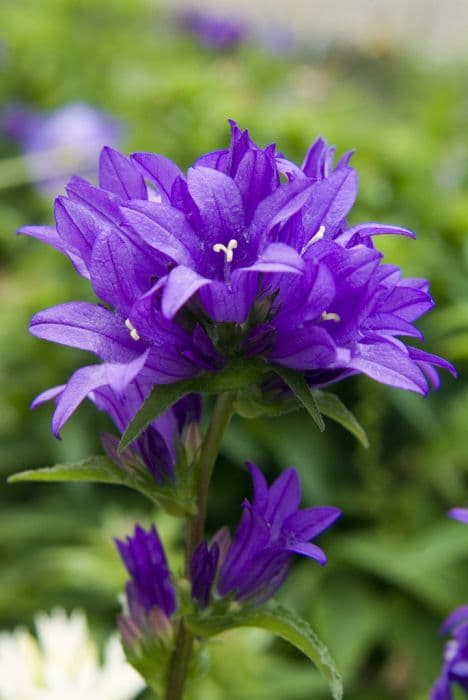Formanek's Bellflower Campanula formanekiana

ABOUT
Campanula formanekiana, commonly known as Formanek's Bellflower, is a flowering perennial known for its delightful display of blooms. The plant typically bears lush, green foliage that forms a backdrop for its signature bell-shaped flowers. The leaves are often lance-shaped or ovate, with a texture that can be smooth or slightly hairy, depending on the variety. The appearance of Formanek's Bellflower is particularly noted for the color and form of its flowers. These blossoms are usually arranged in clusters that hang or droop gracefully from the stems. The flowers themselves are a striking shade of blue to violet, although color intensity can vary, sometimes showing lighter hues or white elements. Each individual flower resembles a small bell or a funnel, with flared edges that give them a whimsical charm. The bell-shaped flowers of the Formanek's Bellflower typically have five lobes that are fused at the base, creating the bell shape that is characteristic of the genus. The inside of the flowers often exhibits delicate veining, which may be more pronounced in some specimens and can contribute to the intricate beauty of each bloom. Formanek's Bellflower typically blooms during the summer months, bringing a vibrant splash of color to garden settings. When in flower, these plants can become a focal point in the landscape, attracting pollinators such as bees and butterflies due to their nectar-rich blossoms. Overall, the picturesque nature of the Formanek's Bellflower, with its lush foliage and enchanting blue to violet bell-shaped flowers, makes it a desirable plant for gardeners seeking to add a touch of elegance and charm to their outdoor spaces. However, as a plant enthusiast, always remember to provide the right care and conditions to ensure healthy growth and an abundant display of these captivating blooms.
About this plant
 Names
NamesFamily
Campanulaceae
Synonyms
Formanek's Bellflower, Formanek's Campanula
Common names
Campanula formanekiana
 Toxicity
ToxicityTo humans
Campanula formanekiana, commonly known as the bellflower, is generally regarded as non-toxic to humans. Therefore, there are no well-documented symptoms of poisoning or toxic consequences associated with ingesting parts of this plant. It is always advisable to exercise caution and not consume plants without certainty of their safety.
To pets
The bellflower (Campanula formanekiana) is not known to be toxic to pets. It is not listed among the plants commonly recognized as poisonous to dogs, cats, or other domestic animals. Consequently, ingestion of this plant is not typically associated with poisoning symptoms in pets. However, it is still prudent to monitor pets for any unusual reactions after ingestion and to keep an eye on the amount consumed, as overconsumption of any non-food item can potentially lead to gastrointestinal upset or other health issues.
 Characteristics
CharacteristicsLife cycle
Perennials
Foliage type
Deciduous
Color of leaves
Green
Flower color
Blue
Height
1 foot (30 cm)
Spread
1 foot (30 cm)
Plant type
Herb
Hardiness zones
8
Native area
Balkans
Benefits
 General Benefits
General Benefits- Decorative Aesthetics: Campanula formanekiana, commonly known as Formanek's bellflower, provides a splash of color with its vibrant blue or violet flowers, enhancing garden visual appeal.
- Attracts Pollinators: The bell-shaped flowers attract beneficial pollinators such as bees and butterflies, supporting local ecosystems.
- Drought Tolerance: Once established, Formanek's bellflower is relatively drought-tolerant, making it suitable for xeriscaping or low-water gardens.
- Low Maintenance: The plant generally requires minimal care, making it a good choice for gardeners looking for low-maintenance options.
- Ground Cover: With its spreading habit, it can be used as an effective ground cover, preventing soil erosion and suppressing weeds.
- Garden Versatility: It can be planted in rock gardens, borders, or as an underplanting for shrubs, offering flexibility in garden design.
- Cooling Effect: The foliage and flowers can contribute to a cooling effect in the garden by providing shade and transpiring moisture.
 Medical Properties
Medical PropertiesThis plant is not used for medical purposes.
 Air-purifying Qualities
Air-purifying QualitiesThis plant is not specifically known for air purifying qualities.
 Other Uses
Other Uses- Edible decoration: The flowers of Campanula, also known as bellflower, can be used as edible garnishes for salads and desserts, adding a splash of color and a touch of elegance.
- Fairy gardens: Due to its delicate appearance, bellflower can be integrated into fairy gardens to create a whimsical landscape that captures the imagination.
- Dye production: The petals of the bellflower may be used to produce natural dyes for coloring fabrics, yarns, or crafts.
- Photography: Bellflowers, with their distinctive shape and range of colors, can provide an excellent subject for botanical photography.
- Educational resource: Bellflowers can be used in educational settings, such as school gardens, to teach children about plant biology and pollination.
- Landscape design: Bellflower can be utilized to create beautiful vertical accents in rock gardens or to add depth and texture to border plantings.
- Craft material: The dried flowers of bellflower can be used in crafting, for example in homemade potpourris or as natural confetti.
- Culinary experiments: The tender young leaves of bellflower may be used in small quantities to add flavor and visual interest to inventive culinary dishes.
- Plant competitions: Bellflower enthusiasts might cultivate Campanula formanekiana for plant competitions, focusing on its aesthetic qualities and unique characteristics.
- Artistic inspiration: The bellflower can serve as an inspiration for artists and designers, influencing patterns, shapes, and motifs in various art forms.
Interesting Facts
 Feng Shui
Feng ShuiThe plant Campanula formanekiana, commonly known as Adriatic bellflower, is not commonly referenced in Feng Shui practice.
 Zodiac Sign Compitability
Zodiac Sign CompitabilityThe plant Adriatic bellflower is not used in astrology practice.
 Plant Symbolism
Plant Symbolism- Perseverance: Campanula formanekiana, commonly known as bellflower, often grows in challenging environments, representing the idea of enduring and persisting through difficulties.
- Gratitude: The bellflower can symbolize thankfulness, possibly due to its habit of returning each year, reminder of ongoing appreciation.
- Constancy: Bellflowers are known for their enduring blooms and perennial nature, symbolizing loyalty and unchanging affection.
- Hope: As a plant that pushes through soil to bloom, bellflowers signify hope and the expectation of better things to come.
- Humility: The bell shape of the flower, often facing downwards, can represent humility, suggesting a gentle and modest demeanor.
 Water
WaterThe Adria Bellflower should be watered thoroughly, allowing the soil to dry out slightly between waterings. This generally means watering about once per week with about one gallon of water, but the exact frequency can vary depending on environmental conditions and the size of the plant and pot. During the growing season, keep the soil consistently moist but not waterlogged. Reduce watering in the winter months when the plant's growth slows down.
 Light
LightThe Adria Bellflower prefers bright, indirect light to thrive. It's best positioned in a spot where it can receive plenty of light without being exposed to the harsh midday sun. An east- or west-facing window that provides several hours of morning or late afternoon sun is ideal.
 Temperature
TemperatureThe Adria Bellflower does well in moderate temperatures, thriving best between 60 to 75 degrees Fahrenheit. It can tolerate minimum temperatures of 50 degrees Fahrenheit for short periods. Avoid exposing the plant to temperatures below 50 degrees, as it may cause damage to the plant.
 Pruning
PruningPrune the Adria Bellflower to remove dead or damaged foliage and to encourage bushier growth. Pruning should be done after the plant has finished flowering, usually in late summer or early fall. It isn't typically necessary to prune more than once a year, unless you're removing unhealthy tissue.
 Cleaning
CleaningAs needed
 Soil
SoilFor the Adriatic bellflower, mix loamy soil with compost and perlite to ensure good drainage. A soil pH slightly alkaline to neutral, around 7.0 to 8.0, is ideal for this plant.
 Repotting
RepottingAdriatic bellflower should be repotted every 2-3 years to refresh the soil and accommodate root growth.
 Humidity & Misting
Humidity & MistingAdriatic bellflower prefers moderate humidity levels, typical of indoor environments, without the need for special humidity adjustments.
 Suitable locations
Suitable locationsIndoor
Place in bright, indirect light and ensure well-draining soil.
Outdoor
Choose a sunny spot with some afternoon shade and well-draining soil.
Hardiness zone
4-8 USDA
 Life cycle
Life cycleCampanula formanekiana, commonly known as Formanek's bellflower, typically begins its life cycle with seed germination, occurring under suitable conditions of moisture and temperature in the spring. After germination, the seedling stage follows, where the plant develops its first true leaves and root system. As the bellflower progresses into its vegetative stage, it continues to grow foliage and stems, building a robust plant structure. Upon reaching maturity, the reproductive stage begins, marked by the formation of distinctive bell-shaped blue or violet flowers, usually during the summer months. Following pollination, which is often facilitated by bees and other insects, the plant produces fruit containing seeds, which complete the cycle by dispersing into the surrounding environment for future germination. Campanula formanekiana may also grow vegetatively through its root system or split rosettes, enabling clonal reproduction and spread alongside its seed-based propagation.
 Propogation
PropogationPropogation time
Spring to summer
The most popular method for propagating Campanula formanekiana, commonly known as the Formanek's Bellflower, is through seed sowing. The best time to sow seeds is usually in the spring after the danger of frost has passed. The seedlings require light for germination, so the seeds should be sown on the surface of a well-draining soil mix and not covered. In order to maintain a moist environment for the seeds, the container can be covered with a clear plastic wrap or placed in a greenhouse until germination, which can take 2-3 weeks. Once the seedlings have grown large enough to handle, they can be transplanted into individual pots or their final position in the garden.








